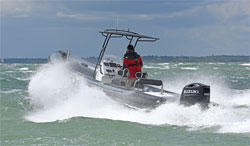

As well as their success in home waters the latest MCA-coded craft from Island RIBs are also doing rather well in Antarctica
Island RIBs know how to build RIBs extremely well. Managing director Alex Cottle is an engineer with a meticulous eye for detail, uncompromising focus on quality and well thought-out designs that culminate in a range of boats that are different from most run-of-the-mill production units.
Many Island RIBs have gone into the yacht tender and chase boat market. Recently two were sold to the British Antarctic Survey and will be used at the Rothera research station for scientific survey work, diving and crew and equipment transport. Island RIBs’ 7m series craft are type tested to MCA cat. 3 (R), allowing commercial operators to work up to 20 miles from a safe haven. This is the maximum category possible for an open boat.
Island RIBs’ hull design gives a dry and smooth ride thanks to a high bow, deep forefoot and, very importantly, weight distribution. This is a key factor in their design. Fixed seating is centred around and astern of the longitudinal centre of gravity. Fuel tank and console positions are adjusted to suit the engine specification, so each boat performs and handles in the same manner. The helmsman can be confident that the boats’ performance will be altered little by additional crew or cargo weight – even when travelling at speed in open water.
Recently in the Solent, we encountered steep confused seas due to a force six westerly. The 7.5 metre model we were in had a total displacement of 14 tonnes including helmsman and passenger, 150 kilos of fuel, powered by a 200 hp four stroke Suzuki outboard. The ride was smooth and dry motoring directly into the short choppy seaway and even better at an angle of 45 degrees both into and off the wind. We were achieving speeds of up to 40kts, but a lower speed of 25kts gave a more comfortable ride. Fuel consumption, read from the onboard computer was 0.9 litres per mile. The tapered seat with its winged backrest frame was be comfortable and secure, and it looked good. The hull gripped the water and was surprisingly solid, providing a safe working tool.
RIBs are not all about speed, they need to tow, manoeuvre in tight spaces, carry live loads and gear. International marine photographer Rick Tomlinson has been working for many years in all sorts of conditions from a variety of boats and aircraft. He says his preferred boat is an Island RIB. ‘They are safe, robust, give a good platform for me to take my images and above all, the driest RIB I have used,’ he says. Fairly high on the checklist when you have a crate of expensive camera gear on board.
Below: A mere force 6 in the Solent is a walk in the park for these RIBs

Island RIBs fit sensible, functional deck equipment. Cleats and bollards are well secured with the stainless steel fittings taken right through to the deck and main structure of the mouldings. The attention to detail in the build speaks quality with 12mm mat laid fore and aft. Marine grade stainless steel fuel tanks are fitted in hull voids, but still serviceable. The polyester layup is hand rolled in a climatically controlled environment. Unusually for a RIB, the hull and deck are fully flow-coated both inside and out giving a completely waterproof layer and preventing water ingress into the vessel’s structure which can cause it to deteriorate over time.
Tinned copper wiring looms are laid in moulded trays and tested before installation. The full-height windscreen, another component designed and manufactured in-house, is made from moulded 6mm polycarbonate, which is heated in a purpose-built oven and then formed into a compound curve before being carefully fitted. The industry standard material for RIB windscreens is Perspex, which is cheap and easy to shape but although strong, it cracks and can shatter on impact. Island RIBs’ polycarbonate windscreens are completely shatterproof – a fact demonstrated enthusiastically by Alex, and they are coated to improve resistance from abrasion and discolouration from exposure to UV.
Alex and his business partner, the well regarded RIB designer Brian Hallett, together with their team of four build their RIBs in Cowes on the Isle of Wight. Their workshop is clean and tidy, no dust, no mess, just five high-quality boats in various stages a build. The company trains in-house, the traditional way, good for the business and employees.
Every Island RIB is built to order, and Alex works closely with every customer to ensure that the finished product is correctly specified for its intended use. This seems to work, these RIBs hardly ever come onto the second-hand market and when they do, the customer tends to buy the replacement from Island RIBs.
Click here for more information on Island RIBs »
We invite you to read on and find out for yourself why Seahorse is the most highly-rated source in the world for anyone who is serious about their racing.
To read on simply SIGN up NOW
Take advantage of our very best subscription offer or order a single copy of this issue of Seahorse.
Online at:
www.seahorse.co.uk/shop and use the code TECH20
Or for iPad simply download the Seahorse App at the iTunes store


